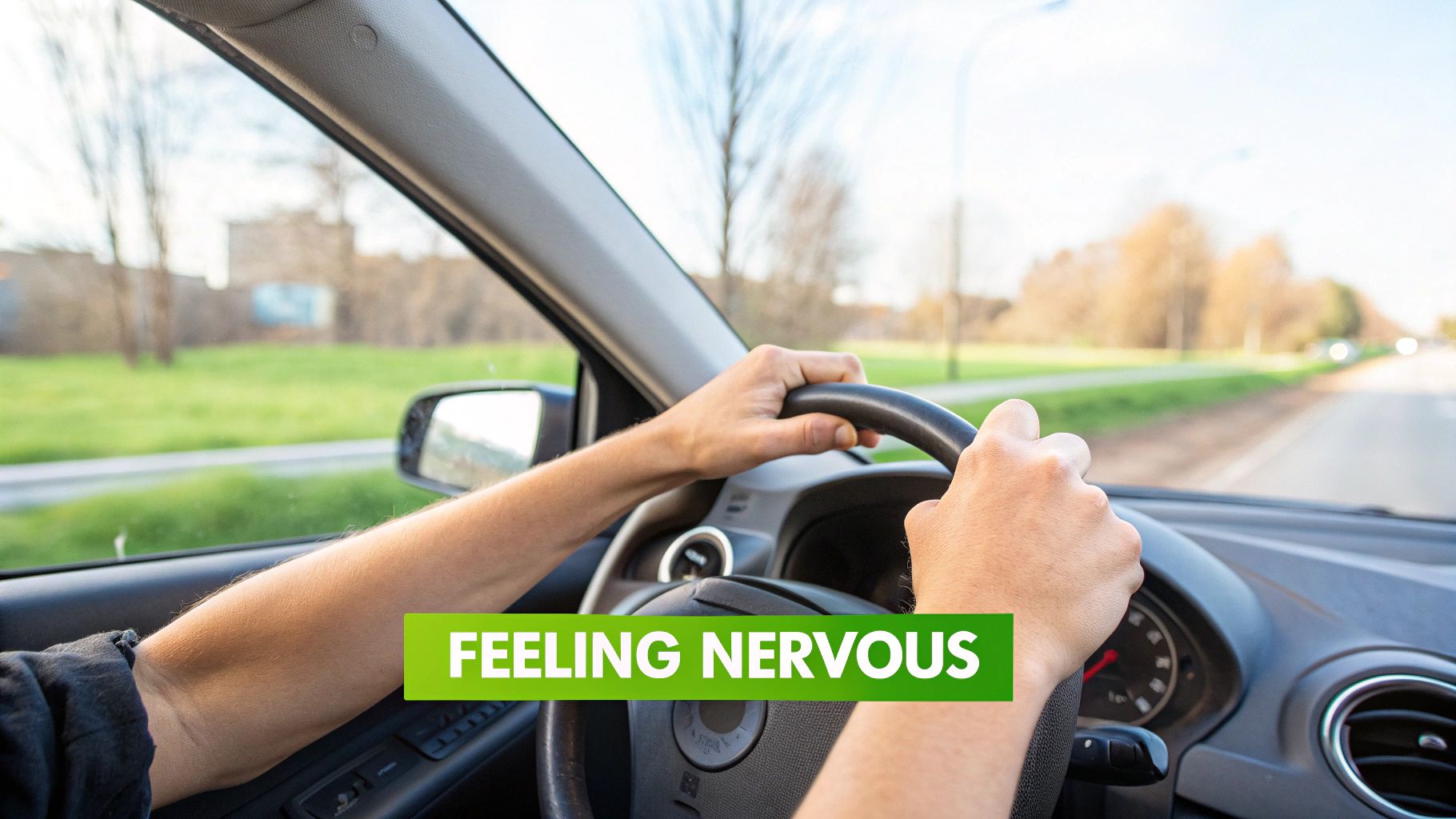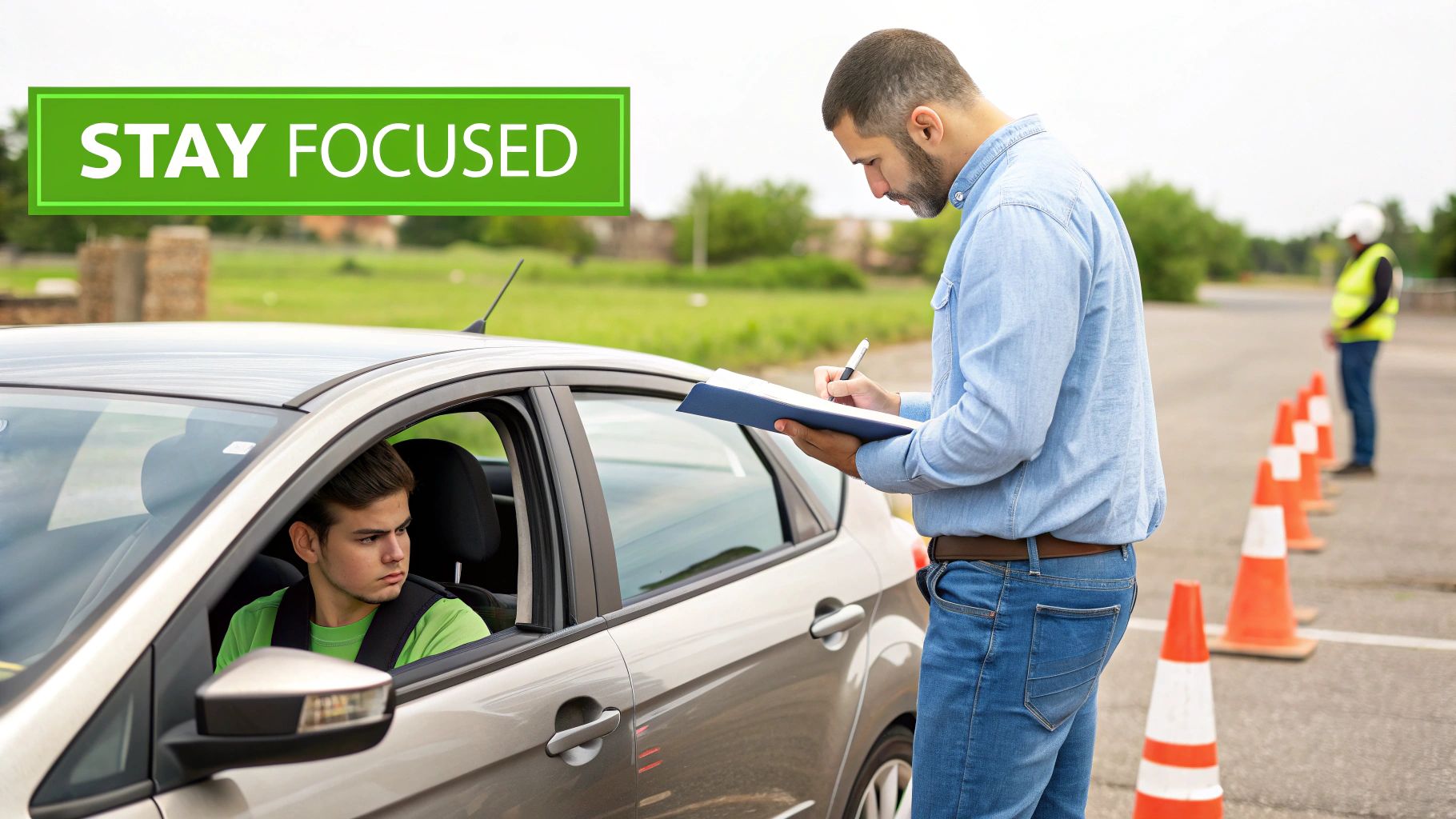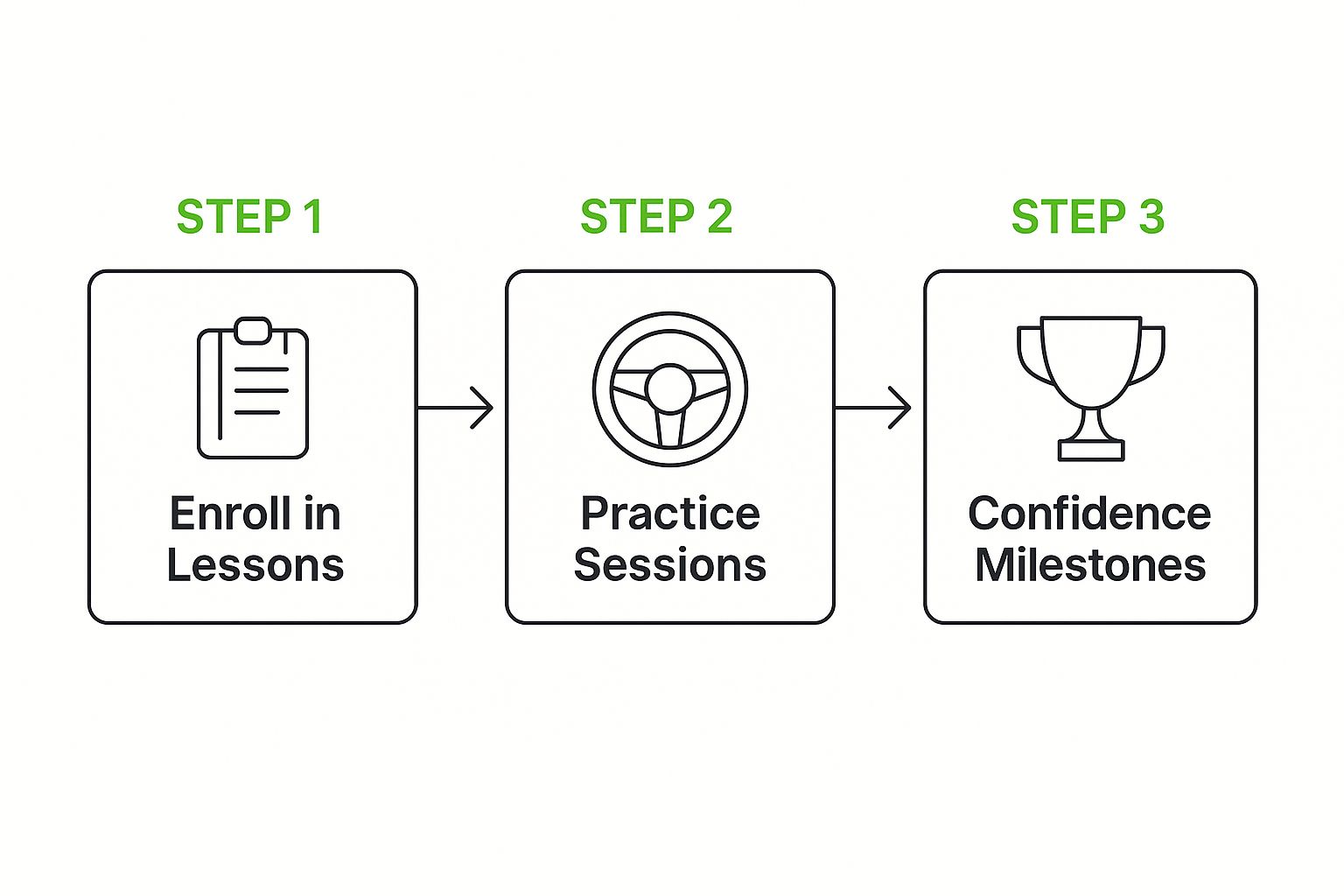If the very thought of getting behind the wheel makes your stomach do flip-flops, I want you to know that's completely normal. Specialised driving lessons for anxious drivers aren't about throwing you in at the deep end. Far from it. They're about creating a calm, supportive space where you can build your skills—and your confidence—at a pace that feels right for you. Trust me, you are not the only one feeling this way.

Getting to Grips with Driving Anxiety Before You Even Turn the Key
That feeling of dread when you think about driving has a name: driving anxiety, or amaxophobia. It’s incredibly common, affecting everyone from brand-new learners to seasoned drivers who’ve had a bad experience.
The scale of the problem here in the UK is quite revealing. A Nissan survey found that a staggering 39% of drivers experience fear or anxiety behind the wheel. This isn't just a case of mild nerves; the anxiety often attaches itself to very specific situations that can feel completely overwhelming. You can read more about these common driving fears in this insightful piece from Zoella which breaks down the full study.
What's Fuelling the Fear?
Figuring out why you feel so anxious is the first real step towards feeling better. This fear isn't just random static in your head; it’s almost always tied to specific worries or memories. From my experience, most anxious drivers are grappling with a few common concerns.
These often boil down to:
- The fear of a catastrophic mistake: The weight of potentially causing an accident and hurting someone is a huge source of stress.
- A bad past experience: Maybe you had a tough informal lesson with a stressed-out parent, or you witnessed a collision that stuck with you.
- Feeling judged by other drivers: Being tailgated, beeped at, or feeling rushed by impatient people on the road can make you feel like you're under a microscope.
- Information overload in tricky situations: Trying to process everything at once on a complex roundabout, a fast-moving motorway, or during a tight parallel park can feel impossible.
To help you start identifying what might be affecting you, I've put together a quick table. Think of it as a starting point to help you connect your feelings to a specific situation.
Common Anxiety Triggers and Initial Coping Strategies
| Anxiety Trigger | Why It's Stressful | Initial Strategy to Try |
|---|---|---|
| Busy Junctions & Roundabouts | Too much to look at; fear of choosing the wrong lane or pulling out at the wrong time. | Start by being a passenger. Observe the flow of traffic without the pressure of driving. Ask your instructor to break it down into simple steps on a quiet practice route. |
| Motorway Driving | The high speeds and feeling "trapped" between other fast-moving vehicles. | Begin with dual carriageways, which are similar but often less intense. Focus on maintaining a safe following distance to give yourself more time and space. |
| Other Drivers' Behaviour | Feeling pressured by tailgaters, aggressive drivers, or horns. | Remember their impatience is their problem, not a reflection of your driving. Focus on your own safe space and practice letting them pass when it is safe to do so. |
| Making a Mistake | Worrying about stalling, taking the wrong turn, or being judged for an error. | Reframe "mistakes" as "learning opportunities." Every driver stalls. The goal is to learn how to recover calmly, which is a skill in itself. |
Recognising your own triggers is the key that unlocks progress. Is it the sheer speed of a motorway that gets your heart racing? Or the unpredictability of a busy high street? When you can pinpoint the what and the why, you and your instructor have a clear roadmap.
It's crucial to understand that these fears are not a weakness. They are a logical response to seeing driving as a high-stakes activity—which, without the right skills, it absolutely can be. The whole point of good driving tuition is to lower those stakes by building your competence and control, one step at a time.
This knowledge turns that big, vague cloud of dread into a series of smaller, manageable challenges. Together, you and your instructor can tackle them head-on with targeted practice and the right kind of support.
How to Find the Right Driving Instructor
Finding the right driving instructor is, without a doubt, the most important decision you'll make. This person isn't just there to show you how to work the pedals and mirrors. They're your coach and your anchor, especially when your nerves start to fray. A good connection can completely change your learning experience, so it's worth putting in the effort to find someone who genuinely understands how to support a nervous learner.
A standard instructor can teach you the mechanics of driving, sure. But one who's experienced with anxiety knows it's about so much more than that. They understand the battle isn't just with the clutch or the roundabouts; it’s with what’s happening in your head.
Look for Specialised Experience
Your search needs to be more specific than just typing "driving school near me" into Google. Instead, try searching for terms like "driving lessons for anxious drivers" or "nervous driver specialist". If a school or instructor highlights this on their website, it’s a great sign they see it as a real area of expertise.
An instructor who truly gets it won't be fazed when you talk about your fears. In fact, they’ll probably have a plan ready to go. They'll appreciate that progress isn't always a straight line and that some lessons will feel harder than others.
Key Takeaway: Patience is non-negotiable. If you get even a whiff of being rushed, judged, or dismissed during an initial chat, walk away. They are not the right fit. Your emotional comfort is just as important as your physical safety.
Questions to Ask Before You Book
Don't ever feel shy about interviewing a potential instructor. Think of it as a two-way street. A great instructor will welcome your questions and be happy to explain their approach. This first conversation is your best chance to see if you'll click.
Here are a few essential things to ask:
- "Do you have much experience teaching very anxious or nervous pupils?" You're listening for a confident "yes," ideally followed by a few examples of how they adapt their lessons.
- "How do you structure lessons for someone who gets overwhelmed easily?" A good answer will involve starting in quiet, simple locations (like an empty car park or industrial estate), breaking down manoeuvres into tiny, manageable chunks, and mastering one thing before moving on.
- "What would you do if I had a moment of panic during a lesson?" The right response should be calm and reassuring. They should mention pulling over safely, talking you through it, and maybe even using simple breathing techniques to get you centred again.
- "Are your training cars fitted with dual controls?" For any learner, this is a must. For an anxious one, knowing the instructor has a safety net and can intervene instantly is a massive confidence booster.
You're looking for someone who sounds more like a calm co-pilot than a drill sergeant. For a deeper dive, our complete guide on what to expect from anxiety driving lessons can offer more helpful context. After the call, trust your gut.
Spotting the Red Flags
Knowing what to avoid is just as crucial as knowing what to look for. The wrong instructor can seriously knock your confidence and make your driving anxiety even worse.
Be on high alert for anyone who:
- Seems impatient or gets easily frustrated.
- Makes unrealistic promises, like guaranteeing a pass in a set number of weeks.
- Brushes off your anxiety with unhelpful comments like, "You'll just get over it."
- Pushes you to book and pay for a big block of lessons before you've even had a trial run.
Taking the time to find a patient, empathetic, and experienced professional is an investment. It can transform your driving lessons from something you dread into a clear, supportive path to getting your licence and the freedom that comes with it.
Your Pre-Lesson Mental and Physical Checklist

A good driving lesson doesn't just start the moment you turn the key. The groundwork is laid long before you even see your instructor's car pull up. Think of the hours leading up to your lesson as your chance to get your head in the game and calm your body down.
By creating a simple, repeatable pre-lesson routine, you send a powerful signal to your brain that you're prepared and in control. This isn't just about grabbing your provisional licence; it's a deliberate strategy to lower your background anxiety and give yourself a solid foundation for learning.
Settle Your Mind and Body
Your physical comfort has a direct line to your mental state. If your body is tense and jittery, your mind will have a much harder time focusing. A few small tweaks can make a world of difference.
- Ditch the Caffeine: I know, that morning coffee or tea is a ritual for many. On lesson days, however, stimulants can seriously amplify anxiety, making your heart race and your hands feel shaky. Consider swapping to decaf or a calming herbal tea instead.
- Dress for Comfort and Movement: You need to be able to move your arms and legs freely without feeling restricted. Tight jeans, a bulky coat that hinders shoulder checks, or anything that might make you overheat will only add to your stress.
- Wear the Right Shoes: This one is non-negotiable. Flat, thin-soled shoes like trainers are perfect. They give you a much better feel for the pedals. Clunky boots or heels can make your footwork clumsy, leading to jerky stops and starts that will only rattle your nerves more.
A fantastic little trick I tell all my anxious students is to try "box breathing" a few minutes before the lesson. It's simple: breathe in for a count of four, hold for four, breathe out for four, and wait for four before starting again. This is a brilliant way to slow your heart rate and short-circuit that initial panic.
Prepare for Specific Challenges Like Night Driving
Let's be honest: driving at night feels completely different. It's not just in your head. The reduced visibility and headlight glare can ramp up the pressure significantly.
Research backs this up. A survey about UK drivers' biggest fears found that anxiety shoots up after dark, with 47.6% of drivers reporting more fear at night, compared to just 10% in the daytime. In fact, more than half of all UK drivers admit to feeling nervous on the road, and 37.6% have avoided driving altogether because of their anxiety. You are definitely not alone.
If you have an evening lesson coming up, just add a couple of extra steps to your prep:
- Make sure your glasses (if you wear them) are spotless to minimise glare from oncoming headlights.
- If your instructor mentioned the route, spend a few minutes visualising it.
- Remind yourself that it's perfectly normal to be more cautious. Give yourself permission to drive a little slower and take your time.
By making this routine a habit, you show up to your lesson feeling grounded instead of frazzled. You're setting the stage for a productive session, one where you can actually absorb what you're being taught and build that crucial muscle memory. This is how you start taking back control from your anxiety.
In-the-Moment Techniques to Manage On-the-Road Anxiety
No matter how well you prepare, some moments behind the wheel will test your nerve. It could be anything—a sudden downpour, a notoriously tricky roundabout, or the unnerving sight of an impatient driver glued to your rear bumper. When that happens, your body's alarm bells start ringing. The trick is having a few go-to techniques to bring yourself back from the edge.
When panic starts to set in, your brain can feel like it’s short-circuiting. The very first thing to do is pull your focus back into the car and into your own body. This is a brilliant technique called grounding, and you can do it so subtly that no one would even notice.
Try focusing on the physical sensations of driving. What does the steering wheel actually feel like under your fingertips? Is it smooth, textured? Notice the slight pressure of your back against the driver's seat. Feel the solidness of your feet on the pedals. This simple act of noticing physical feelings anchors you firmly in the present, stopping that runaway train of "what if" thoughts.
Taming Your Inner Critic with Positive Self-Talk
Let's be honest, anxious thoughts are often fuelled by that nagging inner critic—the one whispering that you’re about to mess up or that you just aren't cut out for this. Learning to talk back to that voice is a game-changer.
Instead of letting those negative thoughts spiral, you need to actively replace them with something more rational and encouraging. Say you stall at a traffic light and your mind immediately jumps to, "Great, now everyone thinks I'm an idiot!" That's your cue to step in.
- Negative thought: "I've stalled and now everyone is angry."
- Positive self-talk: "It’s okay, stalling happens. I know exactly what to do. I'll restart the car, check my mirrors, and go when it's safe. It's a matter of seconds."
This isn't about pretending you're not nervous. It's about coaching yourself through a wobbly moment, just like a good instructor would. You acknowledge the reality of the situation and then give yourself a clear, calm command to follow.
Practical Responses to Common Stressful Scenarios
Let's put this into practice with a couple of real-world situations that rattle even the most seasoned learners.
Scenario 1: The Aggressive Tailgater
You glance in your rearview mirror and there's a car so close you can count the driver's fillings. Your heart starts to pound.
- Action: Take a slow, deliberate breath. Your focus belongs on your driving and maintaining a safe gap in front of you, not on the driver behind. Tell yourself, "Their impatience is their problem, not mine." As soon as it’s safe to do so, signal and pull over to let them pass. Whatever you do, don't speed up—that just hands them control.
Scenario 2: Stalling at a Busy Junction
The engine cuts out. The silence is deafening, and you can feel the weight of every car waiting behind you.
- Action: First, secure the car. Handbrake on. Now, take one deep breath. Talk yourself through the restart process, step-by-step. "Okay, handbrake is on. Gearstick to neutral. Restart engine. Find the bite point. Check mirrors. Go." This methodical approach stops panic in its tracks.
Your instructor is your co-pilot. If you feel overwhelmed, use a simple, clear phrase like, "I need to pull over for a moment." There is absolutely no shame in this. A good instructor will welcome this kind of communication and help you reset before you continue.
Speaking up isn't a sign of failure; it’s a sign of self-awareness and being in control. Learning to handle these moments is every bit as important as nailing a parallel park. For a deeper dive, our guide on how to overcome driving anxiety has plenty more strategies.
Remember, every time you successfully manage a stressful situation, you're building resilience. You're proving to yourself, one junction at a time, that you can absolutely handle this.
How to Rebuild Confidence After a Bad Drive
Let's be honest: every single learner has a bad driving lesson. It’s almost a rite of passage.
It might be a session where nothing seems to go right, a scary close call that leaves your heart pounding, or just a slow burn of small mistakes that eats away at your self-belief. When you’re already an anxious person, these setbacks can feel absolutely massive.
The most important thing to remember is that one bad drive doesn’t define you or your ability to learn. It’s a single moment, not your entire journey. The real goal isn't to become a driver who never makes mistakes—that's impossible—but to become one who knows how to bounce back. That resilience is what truly builds a confident driver.
This is especially true if your anxiety comes from a past accident. Research from Aviva actually found that a significant 12% of UK drivers feel nervous behind the wheel after a collision. While this can sometimes lead to more careful driving, it can also become so limiting that people avoid driving altogether. You can read more about this in the full Aviva study.
The journey to becoming a confident driver is a gradual one, built lesson by lesson, as this graphic shows.

As you can see, confidence isn't something you just get overnight. It's earned through structured lessons and putting in the practice time.
Turn Setbacks into Stepping Stones
Your mindset is your most powerful tool here. After a tough lesson, the first job is to actively reframe what just happened. It wasn't a "failure"; it was a learning experience, and probably a very valuable one.
Instead of letting your thoughts spiral into "I'm useless, I'll never get this," try to put on your detective hat. What specifically went wrong? Was it a moment of hesitation at a busy roundabout? Did you struggle with clutch control on a hill start? Pinpointing the exact problem turns that vague feeling of dread into a concrete skill you can work on next time.
A huge part of this is the debrief with your instructor. Don't just rush out of the car and stew in your anxiety. Take five minutes to talk it through. A good instructor will help you understand why something happened and will work with you to make a plan for tackling it in your next lesson.
Setting Small Goals for Your Next Drive
After a knock to your confidence, don’t try to conquer the world on your next drive. The goal should be small, achievable, and very specific. This creates a low-pressure situation where you can bank an easy win and start building some positive momentum again.
Here are a few examples of what this looks like in practice:
- Stalled the car a lot? "My only goal today is to find the bite point 10 times in a quiet car park before we even get on the road."
- Overwhelmed by a roundabout? "Today, we're just going to drive past that roundabout a few times so I can watch the traffic flow without any pressure to actually enter it."
- A manoeuvre felt impossible? "All I want to do today is complete one successful reverse park, even if it takes me a few goes and a lot of corrections."
This is a great way to break the cycle of anxiety and avoidance. You can rebuild your confidence from the ground up by setting and achieving these small goals. If you need more ideas, we have some specialised tips on driving lessons for nervous drivers that you might find helpful.
To help structure this process, here's a simple roadmap you can follow to get back on track.
Roadmap for Regaining Confidence
| Step | Action | Purpose |
|---|---|---|
| 1. Debrief | Talk with your instructor immediately after the lesson. Be honest about what rattled you. | To understand the why behind the mistake and prevent negative feelings from festering. |
| 2. Reflect | Later that day, write down what happened and one thing you learned from it. | To process the event constructively and shift your focus from emotion to information. |
| 3. Plan | Agree on one small, specific goal with your instructor for the very start of your next lesson. | To create a low-pressure "win" that immediately starts rebuilding positive momentum. |
| 4. Execute | Focus only on achieving that one small goal. Celebrate it when you do. | To prove to yourself that you can overcome challenges and rebuild skills, step-by-step. |
Following a structured approach like this can feel much more manageable than simply hoping the next lesson will be better. Each small victory chips away at the fear, replacing it with hard-earned competence. You've got this.
Your Anxious Driving Questions, Answered

If you're feeling nervous about learning to drive, you're bound to have questions running through your mind. That’s perfectly normal. In fact, seeking answers is a brilliant first step toward taking control of the situation. Let's tackle some of the most common queries I hear from anxious learners.
Will My Driving Anxiety Ever Go Away Completely?
This is probably the number one question I get asked, and the honest answer is, it depends. For many, the goal isn't to magically erase every single nerve, but to build your skills to the point where you can confidently manage them.
As you gain more experience behind the wheel, you'll likely find that the intense anxiety starts to fade. It gets replaced by a healthy level of awareness, which actually makes you a more careful and considerate driver. The real win is reaching a place where anxiety no longer dictates whether you get in the car.
The aim here is progress, not perfection. You’ll learn the difference between raw fear that holds you back and the natural alertness that keeps you safe. It’s about making sure your nerves aren't calling the shots.
What if I Have a Panic Attack During a Lesson?
This is a massive fear for so many people, but it’s something any good instructor specialising in nervous drivers is completely prepared for. If you start to feel that wave of panic rising, the most important thing you can do is speak up. Just say, "I need to pull over for a minute."
Your instructor will immediately and calmly guide you to a safe spot to stop the car. They won't be annoyed or judgmental—their only priority is you. From there, they can talk you through some simple grounding techniques or breathing exercises to help you feel centred again. A true professional sees this as part of the journey and will handle it with patience and care.
How Many Lessons Will I Need if I'm Anxious?
There’s no set number, and it’s so important not to get caught up comparing yourself to friends or family. Learners struggling with anxiety often find that a slower, more deliberate pace works wonders. This might mean you end up taking more lessons than someone who took to it like a duck to water, and that's absolutely fine.
Your progress will be unique to you and will depend on a few things:
- How deeply your anxiety affects you.
- How often you can have lessons.
- Whether you can get any private practice in between.
- How well you and your instructor 'click'.
The key is to focus on mastering one skill at a time and letting your confidence build naturally. Trying to rush towards a test will just crank up the pressure and make your anxiety worse.
Ready to start your journey with a patient, supportive instructor who truly gets it? At Fast Pass Driving Courses, we specialise in helping nervous drivers find their confidence and pass their test. You can find out more about our tailored courses and book your first lesson today.

